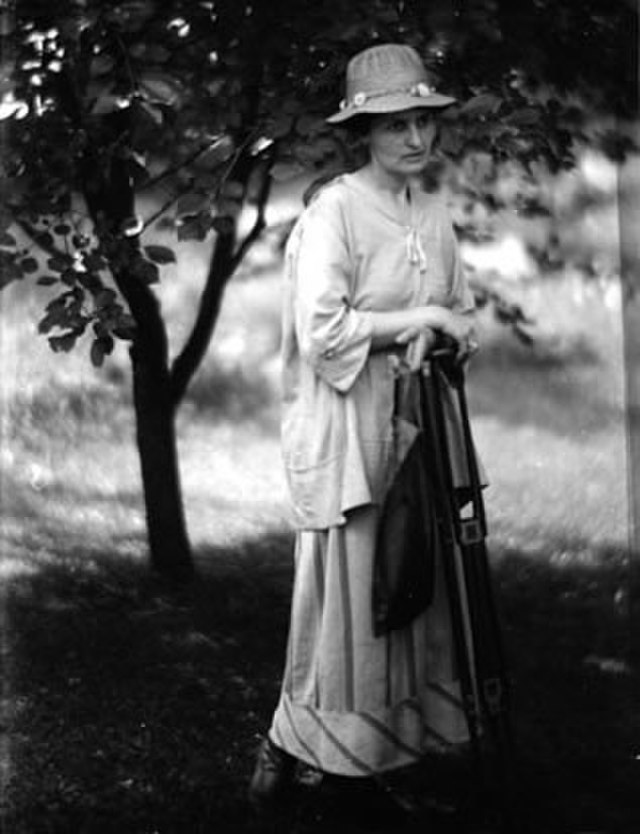Doris Ulmann was an American photographer, best known for her portraits of the people of Appalachia, particularly craftsmen and musicians, made between 1928 and 1934. Doris Ulmann was a native of New York City, the daughter of Bernhard and Gertrude (Mass) Ulmann. Educated at the Ethical Culture Fieldston School, a socially liberal organization that championed individual worth regardless of ethnic background or economic condition and Columbia University, she intended to become a teacher of psychology. Her interest in photography was at first a hobby but after 1918 she devoted herself to the art professionally.
She practiced Pictorialism and was a member of the Pictorial Photographers of America. Ulmann documented the rural people of the South, particularly the mountain peoples of Appalachia and the Gullahs of the Sea Islands, with a profound respect for her sitters and an ethnographer's eye for culture. Ulmann was trained as a pictorialist and graduated from the
Clarence H. White School of Modern Photography. Other students of the school who went on to become notable photographers include
Margaret Bourke-White,
Anne Brigman,
Dorothea Lange,
Paul Outerbridge, and
Karl Struss.
Her work was exhibited in various New York galleries, and published in
Theatre Arts Monthly,
Mentor,
Scribner's Magazine, and
Survey Graphic. Ulmann was married for a time to
Dr. Charles H. Jaeger, a fellow Pictorialist photographer and an orthopedic surgeon on the staff of Columbia University Medical School and a likely connection for her 1920 Hoeber publication The Faculty of the College of Physicians & Surgeons, Columbia University in the
City of New York: Twenty-Four Portraits. This was followed in 1922 by the publication of her Book of Portraits of the Medical Faculty of the Johns Hopkins University; the 1925 A Portrait Gallery of American Editors, and in 1933, Roll, Jordan Roll, the text by Julia Peterkin. The fine art edition of Roll, Jordan Roll is considered to be one of the more beautiful books ever produced.
In an interview with Dale Warren of Bookman, Doris Ulmann referred to her particular interest in portraits.
"The faces of men and women in the street are probably as interesting as literary faces, but my particular human angle leads me to men and women who write. I am not interested exclusively in literary faces, because I have been more deeply moved by some of my mountaineers than by any literary person. A face that has the marks of having lived intensely, that expresses some phase of life, some dominant quality or intellectual power, constitutes for me an interesting face. For this reason the face of an older person, perhaps not beautiful in the strictest sense, is usually more appealing than the face of a younger person who has scarcely been touched by life."
Ulmann's early work includes a series of portraits of prominent intellectuals, artists and writers:
William Butler Yeats,
John Dewey,
Max Eastman,
Sinclair Lewis,
Lewis Mumford,
Joseph Wood Krutch,
Martha Graham,
Anna Pavlova,
Paul Robeson, and
Lillian Gish. From 1927, Ulmann was assisted on her rural travels by
John Jacob Niles, a musician and folklorist who collected ballads while Ulmann photographed. In 1932 Ulmann began her most important series, assembling documentation of Appalachian folk arts and crafts for Allen Eaton's landmark 1937 book, Handicrafts of the Southern Highlands. In failing health, she collapsed in August 1934 while working near Asheville, North Carolina, and returned to New York. Ulmann died August 28, 1934.
Upon Ulmann's death, a foundation she had established took custody of her images.
Allen Eaton,
John Jacob Niles,
Olive Dame Campbell (of the John C. Campbell Folk School in Brasstown, North Carolina), Ulmann's brother-in-law
Henry L. Necarsulmer, and Berea schoolteacher
Helen Dingman were named trustees.
Samuel H. Lifshey, a New York commercial photographer, developed the negatives Ulmann had exposed during her final trip, and then made proof prints from the vast archive of more than 10,000 glass plate negatives. (Lifshey also developed the 2,000 exposed negatives from Ulmann's last expedition, and produced the prints for Eaton's book.) The proof prints were mounted into albums, which were annotated by John Jacob Niles and Allen Eaton, chair of the foundation and another noted folklorist, to indicate names of the sitters and dates of capture.
The
Georgia Museum of Art at the University of Georgia organized a major retrospective of her work in 2018 and published the largest book on her work to date. The
Library of Congress Prints & Photographs Division holds more than 150 photographic prints by Ulmann.
Source: Wikipedia
